January 18, 2013 weblog
Researchers devise method to create efficient indium phosphate nanowire photovoltaics
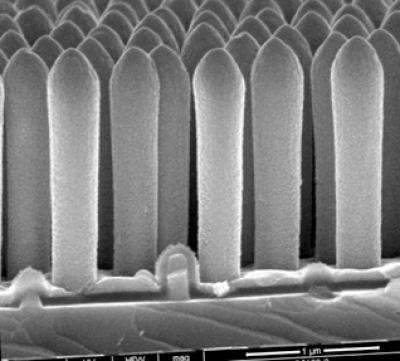
(Phys.org)—Robert F. Service has published a News & Analysis piece in the journal Science describing the progress being made in nanowire photovoltaics. One of those innovations is described in another paper published in the same journal by a team working on indium phosphate nanowire technology. In their paper, they describe how in creating micrometer sized wires they have managed to build a non-silicon based solar cell that is capable of converting almost 14 percent of incoming sunlight into electric current.
Researchers the world over are on a quest to create a cheaper alternative to silicon based solar cells, some of which have been focused on using indium phosphate because it is more efficient at turning sunlight into electricity – unfortunately, it's not very good at absorbing sunlight. In this new research, the team turned to nanowire technology to help it do a better job.
-
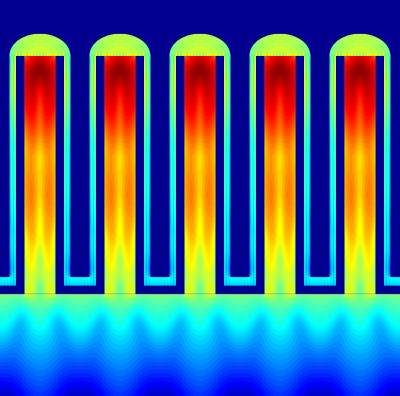
This shows a computer simulation of the absorption in five nanowires. The sunlight comes in from the top. The dark red areas, near the top, have the strongest absorption, while the dark blue areas have the weakest absorption. The simulation was done in three dimensions, but the figure shows a cross-section. Credit: Wallentin et al. -
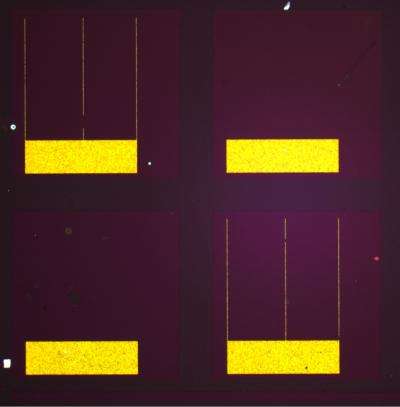
This shows an optical microscope image of four nanowire solar cells. Each cell is a slightly lighter shade of purple in color, while the darker areas in between are inactive. The yellow areas are gold metal pads, which are used for connecting the solar cells to an external load. Each cell contains about 4.5 million nanowires. Credit: Wallentin et al.
The idea is to create a small forest of wires standing on end atop a platform, with each wire just 1.5 micrometers tall and with a diameter of 180 nanometers. The bottom part of each wire is doped to cause an excess positive charge, the top doped to give it an excess negative charge with the middle remaining neutral – all standing on a bed of silicon dioxide. The team caused such a setup to come about by dropping gold flakes on a silicon bed and adding silicon phosphate to cause wires to grow which were kept clean and straight via etching using hydrochloric acid. The result is a photovoltaic cell capable of converting 13.8 percent of incoming sunlight into electricity while absorbing 71 percent of the light above the band gap.
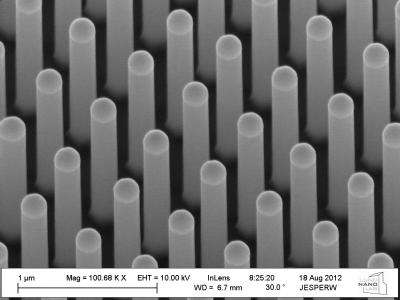
In addition to being nearly as efficient as traditional silicon based solar cells, this new type of cell can also be bent to allow for shaping into flexible panels that allow for more options when mounting. It also allows for a smaller overall surface area. The team suggests that solar cells made using this approach might be best used in concentrated systems using lenses, though it's not clear as yet whether they would stand up to the intense heat. There's also the problem of creating the cells on a scale large enough for them to be sold commercially at a reasonable cost.
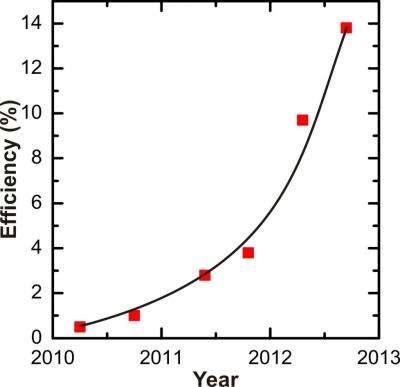
More information: 1. InP Nanowire Array Solar Cells Achieving 13.8% Efficiency by Exceeding the Ray Optics Limit, Science, DOI: 10.1126/science.1230969
ABSTRACT
Photovoltaics based on nanowire arrays could reduce cost and materials consumption compared to planar devices, but have exhibited low efficiency of light absorption and carrier collection. We fabricated a variety of millimeter-sized arrays of p-i-n doped InP nanowires and found that the nanowire diameter and the length of the top n-segment were critical for cell performance. Efficiencies up to 13.8% (comparable to the record planar InP cell) were achieved using resonant light trapping in 180-nanometer-diameter nanowires that only covered 12% of the surface. The share of sunlight converted into photocurrent (71%) was six times the limit in a simple ray optics description. Furthermore, the highest open circuit voltage of 0.906 volt exceeds that of its planar counterpart, despite about 30 times higher surface-to-volume ratio of the nanowire cell.
2. Performance of Nanowire Solar Cells on the Rise, DOI: 10.1126/science.339.6117.263 . www.sciencemag.org/content/339/6117/263.summary
Journal information: Science
© 2013 Phys.org





















